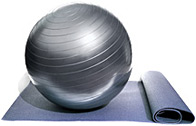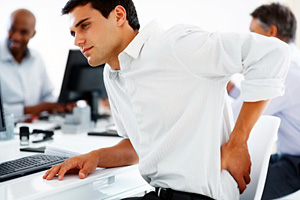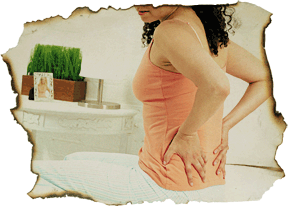Let’s face it, most people do not enjoy stretching. If you think about it, it’s probably close to the bottom of your list of priorities when you work out or do any other type of physical activity. In fact, stretching is probably the most overlooked aspect of physical fitness, and yet it is one of the most important. I continually stress the benefits of stretching to my clients, and the ones who take my advice see a difference in their workouts and everyday lives. By the end of this article, you will have the information and the tools to put together a great stretching program, too.
Why We Need to Stretch
As we age, our muscles tighten and range of motion in our joints decreases. This can impact even the most active lifestyle and hinder your normal day-to-day activities. Tasks that used to be simple, like zipping up a dress or reaching for a can off the top shelf, may become extremely difficult. A regular stretching program can help lengthen your muscles and make daily activities routine again.
The word flexible comes from the Latin word flexus, which means “to bend.” Flexibility is the degree to which an individual muscle will lengthen. Stretching increases flexibility, which will help you perform daily activities and reduce the risk of muscle, joint and tendon injuries. Stretching also improves circulation, increasing blood flow to the muscles. Increased blood flow provides more nourishment to the muscles and gets rid of more waste by-products in the muscle tissue itself. Improved circulation can also help speed up recovery time if you suffer a muscle injury.
What’s more, stretching can help eliminate or decrease low back pain, one of the most common kinds of structural pain, affecting a large percentage of the population. Muscle tightness in the quadriceps, hamstrings, hip flexors, and low back muscles is a common cause of low back pain. Stretching these muscles will often eliminate the pain. Keep in mind that every joint is tied to another joint, so if one muscle is tight, it is going to affect another joint or muscle.
One of the greatest benefits of stretching is that you’re able to increase your range of motion, which means your joints can move further before an injury occurs. Stretching after you exercise (at least after you’ve warmed up a bit) has proven to be much more effective than pre-workout stretches, because by the time you’ve completed your workout, the muscles are “warm.” Post-exercise stretching also helps reduce soreness, improves workout recovery, and ensures muscle and tendons are working properly.
Different Ways to Stretch
There are three main types of stretching/flexibility programs: static (corrective) stretching, active stretching and functional stretching. No matter what type of flexibility program you are on, in the end it will help with posture, relieve muscle tightness and imbalances, prevent injury and improve the quality of everyday activities we take for granted from time to time.
Corrective/static stretching addresses your individual muscle imbalances, which increases extendability in muscles that are chronically tight. Typically, you will perform static stretches, meaning you hold the stretch for 20-30 seconds.
Each stretch should be performed 2-3 times. The main goal of static stretching is to alleviate muscle imbalances, improve posture and prevent injury.
Active stretching gradually increases joint range of motion by moving into and out of stretches in a more rhythmic fashion. You hold each stretch for only 2-4 seconds, performing between five and 10 repetitions of a particular stretch. One of the added benefits of an active flexibility routine is that it strengthens and stretches at the same time. Active flexibility helps improve posture and your quality of movement.
Functional stretching uses muscles and the body’s momentum to take a joint through its full range of motion in dynamic, multiplanar (all directions) ways. Movement mimics those you do in everyday life or your training program, and make for great warm-up activities. Functional flexibility improves posture and the quality of your everyday life.
Static Calf Stretch
Preparation: Stand facing a wall or sturdy object. Bring one leg forward, using your upper body to lean against the wall and keeping the outstretched rear leg straight.
Movement: Draw the belly button inward and keep the rear foot flat and pointed straight ahead; do not allow the rear foot to cave inward or roll outward. Bend the arms, move chest toward the wall and tilt pelvis forward. Stop the movement when slight tension is felt. Hold for 20-30 seconds, switch sides and repeat.
Static Kneeling Thigh and Hip Stretch
Preparation: Kneel with front leg bent at a 90-degree angle. Rotate the back leg slightly inward.
Movement: Draw belly button inward, keeping the rear foot flat and pointed straight ahead. Do not allow the rear foot to cave inward or roll outward. Bend the arms, move chest toward the wall and tilt pelvis forward. Stop movement when slight tension is felt. Hold for 20-30 seconds, switch sides and repeat.
Static Abdominal Stretch Over Ball
Preparation: Lie supine (on your back) on a stability ball, with arms outstretched.
Movement: Draw belly button inward and slowly allow body to drape over the ball, extending legs and reaching with arms. Hold for 20-30 seconds.
Active Stretches
Active Calf Stretch
Preparation: Stand near a wall or sturdy object. Bring one leg forward for support; use upper body and lean against wall. The outstretched leg should form a straight line and the feet and ankle should be in a neutral position.
Movement: Draw belly button inward and keep rear foot on the ground, with opposite hip flexed. Slowly move the hips forward, creating controlled movement through the lower extremity. Hold for 2-4 seconds and repeat for 5-10 repetitions. Switch sides and repeat.
Preparation: Stand with one leg bent and slightly forward. Turn the back leg slightly inward.
Movement: Draw belly button inward and squeeze the glutes while tucking the hips. Stride forward slowly until a mild tension is achieved in the front of the hip being stretched. Raise and stretch the stride-side arm up and over the opposite side while maintaining pelvic position. Rotate to the back leg in a controlled manner, hold for 2-4 seconds for 5-10 repetitions, then switch sides and repeat.
Tube Walking Side to Side
Preparation: Stand with feet hip width apart, knees slightly bent and feet straight ahead. Place resistance band under feet.
Movement: Draw belly button inward. Keep feet straight ahead and take 10 small side steps without allowing knees to cave inward. Repeat in the opposite direction.
Multi-Planar Lunge
Preparation: Stand in proper alignment with hands on hips and feet straight ahead.
Movement: Draw belly button inward. While maintaining total body alignment, step forward (saggital plane), descending slowly by bending at the hips, knees and ankles. Use the hips and thigh muscles to push up and back to the start position. Perform 10 repetitions, then repeat on opposite leg. Progress to side lunges (coronal/frontal plane), followed by turning lunges (transverse plane).
Russian Twist
Preparation: Lie on a ball with your head and neck supported and both feet straight ahead. Lift hips up until they are in line with knees and shoulders.
Movement: Draw belly button inward. Maintaining core control, slowly rotate trunk to each side. Perform 10 repetitions to each side.
Prisoner Squat
Preparation: Stand in proper alignment with hands behind head.
Movement: Draw belly button inward and lower to a 3/4 squat position (controlled); do not let the knees go forward or cave inward. Extend hips, knees and ankles to return to start position. Raise onto toes and then return to start position. Perform 10 repetitions of the entire move, start to finish.
 Well, there you have it in a nutshell: how to start stretching today and take your first steps down the path to a more flexible, healthier you. These stretches should get you started, but there are a lot more you can add to your flexibility routine as you progress. Which muscles are tight will determine what stretches you should be doing. The benefits of stretching are important, so make sure it’s a regular part of your fitness program. Talk to your doctor for more information.
Well, there you have it in a nutshell: how to start stretching today and take your first steps down the path to a more flexible, healthier you. These stretches should get you started, but there are a lot more you can add to your flexibility routine as you progress. Which muscles are tight will determine what stretches you should be doing. The benefits of stretching are important, so make sure it’s a regular part of your fitness program. Talk to your doctor for more information.
Safe Stretching: Four Things Not to Do
There are no disadvantages to stretching – unless, of course, you do them improperly, which is actually easy to do if you don’t know what you’re doing. Here are a few tips to keep in mind before starting any stretching program:
DON’T bounce when stretching; hold your position for the specified time.
DON’T stretch cold muscles; always do some type of warm-up for at least five minutes: jogging in place, walking on a treadmill, light jump rope, etc.
DON’T overstretch. There should be a little discomfort, especially if you’re not used to stretching, but it should not be painful.
DON’T stretch a muscle improperly. If you are not sure of the proper stretch or how to perform it, get some assistance from a professional.
By Chelsea Cooper
 Toddlers have to yet experience these outside contributors to movement dysfunction, otherwise known as life, and therefore move efficiently. The problem is adults don’t’ know they move wrong! They have crossed over to subconscious dysfunction; their brain perceives the abnormal movement patterning as normal. This inefficient movement leads to microtrauma, pain and injury.
Toddlers have to yet experience these outside contributors to movement dysfunction, otherwise known as life, and therefore move efficiently. The problem is adults don’t’ know they move wrong! They have crossed over to subconscious dysfunction; their brain perceives the abnormal movement patterning as normal. This inefficient movement leads to microtrauma, pain and injury. Carpal Tunnel
Carpal Tunnel Tennis Elbow
Tennis Elbow Lower Back Pain
Lower Back Pain What’s your average family meal at home like in terms of portion size? Unless you’ve purchased oversized plates, meals are generally within reason. Not so for an increasing number of fast-food chains and sit-down restaurants. “Super-sized” combo meals and 17-inch plates heaped with Thanksgiving-like portions are a recipe for weight gain. Stick to a reasonable portion size (or eat half and get the other half to go) and you won’t have to unbutton the top button of your jeans midway through your meal.
What’s your average family meal at home like in terms of portion size? Unless you’ve purchased oversized plates, meals are generally within reason. Not so for an increasing number of fast-food chains and sit-down restaurants. “Super-sized” combo meals and 17-inch plates heaped with Thanksgiving-like portions are a recipe for weight gain. Stick to a reasonable portion size (or eat half and get the other half to go) and you won’t have to unbutton the top button of your jeans midway through your meal. Depending on the nature of the establishment, this can be fairly easy or a bit tricky, but either way, it’s a worthy pursuit. Whether it’s a hamburger with lettuce and tomato or a plate of pasta with broccoli, choose meals that have some natural color, courtesy of Mother Nature’s
Depending on the nature of the establishment, this can be fairly easy or a bit tricky, but either way, it’s a worthy pursuit. Whether it’s a hamburger with lettuce and tomato or a plate of pasta with broccoli, choose meals that have some natural color, courtesy of Mother Nature’s In the past few years, the majority of restaurants have begun (by mandate and/or choice) to reveal how nutritionally unsound some of their meal options are. This can range from providing complete nutritional facts to listing calorie counts on the menu. Doing so gives you the upper hand when it comes to choosing a healthy (or at least healthier) meal for you and your family. Visit the Web sites of your favorite restaurants or review the nutritional information in-house before ordering. You’ll be surprised at how much fat, sodium and calories are in some of your favorites; perhaps they won’t be your favorites after you learn what’s in them and you’ll steer toward lower-fat, lower-calorie, better-for-you selections instead.
In the past few years, the majority of restaurants have begun (by mandate and/or choice) to reveal how nutritionally unsound some of their meal options are. This can range from providing complete nutritional facts to listing calorie counts on the menu. Doing so gives you the upper hand when it comes to choosing a healthy (or at least healthier) meal for you and your family. Visit the Web sites of your favorite restaurants or review the nutritional information in-house before ordering. You’ll be surprised at how much fat, sodium and calories are in some of your favorites; perhaps they won’t be your favorites after you learn what’s in them and you’ll steer toward lower-fat, lower-calorie, better-for-you selections instead.